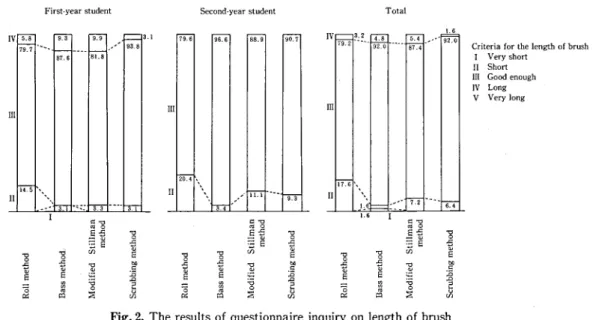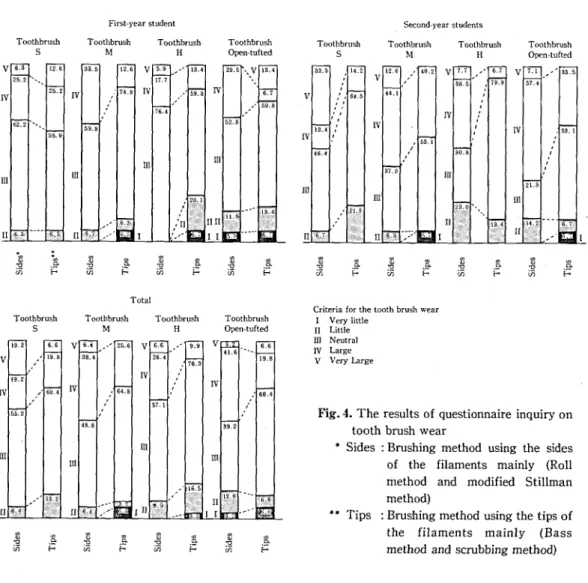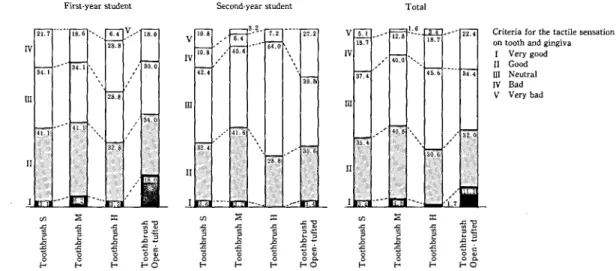(Original)
Matsumoto Shigaku. 12 : 335N341, 1986key words : physical sensation - toothbrushing methods - toothbrush - periodontal disease
A Study on the Physical Sensations
of Four Kinds of Trial Toothbrushes
and Four Different Toothbrushing Methods
NORIO OTA
DePartment of Periodontology, Matsumoto Dental College
(Chief : Prof N. Ota)
YOSHINORI MUSHA
Lion Foundation forJDental Health Laborato2y (Director :. T. Kobaytzshi)SATOSHI HAYASHI and TAKAICHI ISAKA
DeveloPment Laboratories I Lion Co2Poration(Director : L Kadoya)
TAKESHI KONDO
DePartment of Communily Dentdst2y, Matsumoto Dental College
(Chief : Prof T. Kondo)
KEIZO IWAI
DePartment of Prosthodontics II, Matsumoto Dental College
(Chief : Prof M. Amari)
TOSHIO DEGUCHI
DePartmen't of Orthodontics, Matsumoto Dental College
(Chief : Prof T. Deguchi)
HIDEHIRO KAYA
DePartment of Endodontics and Pen`odontics, Fukuoha Dental College
(Chief: Prof H. Kaya)
Summary
Using 65 students of the hygiene school attached to Matsumoto Dental College (35
336 OTA : Physical Sensations of Trial Toothbrushes and Toothbrushing Methods first-year students, 30 second-year stUdents) as subjects, we performed an investigation into the different physical sensations produced when using 4 trial toothbrushes and 4 different
toothbrushing methods. The conclusions are as follows:
1 . t'Length of brush".:
There was a tendency to reply that the length of brush seemed slightly shorter when the students brushed with the Roll method, rather than the other three methods.
2 . ttStiffness of filaments" :
There was a tendency to' reply that the bristle was much harder when the students
brushed with methods from Group B (Methods that primarily use the tip of the bristle)
than with methods from Group A (Methods which use the side of the bristle). 3. 'tTooth brush wear":
A large percentage of students replied that the bristle was more durable when using methods from Group B rather than Group A.
4 . ttPhysical sensation on tooth and gingiva" :
Brush M and the Open-tufted brush, both classified as 'tmedium" stiffness, were
prefer-5 . ttPhysical sensation of holding the handle" :
80-900/o of the students, regardless of the toothbrushing method employed, liked the
handles of the brushes.
Introduction
Toothbrushing is very important to the prevention and treatment of periodontal disease and it is the toothbrush that is most frequently used in oral hygiene, especially to remove dental plaque. There have been many investigation'"'5) into the functions of the toothbrush, such as plaque removal and gingival improvement. However, investigations into the user's physical sensations have been rare.6} Thus, the author performed an investigation into the sensations obtained when using various different toothbrushes and toothbrushing methods.
Materials and Methods
1 ) Sample group of volunteers
65 students of the hygiene school attached to Matsumoto Dental College (35 first-year students, 30 second-year students)
2 ) Toothbrushing methods and trial brushes
Four toothbrushing methods Roll method, Bass method, modified Stillman method, and
Scrubbing method - and four kinds of experimental toothbrushes rnanufactured by Lion company
were used for the investigation.
The shapes of the trial brushes are shown in Table 1, Fig. 1. The shape of the handle is the same in each. The diameter, pitch and disposition of the filament holes of brushes S, M, and H are the same, but the thickness and length of the bristles are different. The diameter and disposition of holes and pitch in the open-tufted brush are different from S's, M's, and H's, and its bristled part is rough. The length of the open-tufted brush's filaments is the same as M's.
iflrasdwf\ 12(3) 1986 337
Brush S: Soft
Brush M and Open-tufted brush : Medium Brush H : Hard
3 ) Method of examination
Students used four kinds of tooth brushes and four toothbrushing methods for a fixed time (one week each for first-year students, two weeks each for second-year students). On the final day they completed a questionnaire. There were four items on the questionnaire : t'Length of brush", tCStiff-ness of filaments", "Tooth brush wear", and t'Tactile sensation to tooth and gingiva", and "Physical sensation of holding the handle". Each item had five estimation stages.
Results and Discussion
D t'Length of brush"
The length of brushes S, M, and H were 23.6 mm in length, and 24.2 mm for the Open-tufted
brush. Because they are all about the same Iength, then, the results can be summed up according to
toothbrushing methods only.
As can be seen in Fig. 2, compared with the other three toothbrushing methods, there was a
large response that length of brush seemed short when the students brushed with the roll method. Although with the three other methods students moved the brush horizontally, with the roll method they revolved it vertically. Consequently with the roll method only two or three teeth could be
Table 1. Specification of trial toothbrushes
xstl::tt::tems Diameterof
Tooth-brushes hole(mm)
PitchÅqmm)
Arrangement Diameter* Height of Length of
filaments(mil} filaments(mm) brush(mm)
s 1,8 3,2
2+3 6+2
6 10 L)4.2M
1,8 3,22+3 6+2
8 11 24,2H
1.8 3,22+3 6+3
10 12 242 Open-tufted 1,8 4.226
8 ll 23.6 sM
Open-tufted H338
OTA:
First-year student
Physical Sensations of Trial Toothbrushes and Toothbrushing Methods
5.8 9.3 9.9 3. 79.7 938 IV III II .- --'. '. 87.6 Bl.S 145 . 3.1 --!- 33 1 8 s e B ec I Toothbrush s g Åí o E gg tu m Second-year student III II 79.6 96.6 S8.9 9e.7 20.4 ,1..`.. .-+ ILI 9.3 4 !.6 4.S 5.4 ---- 92.0 IV mII 79.2 3.2 -1xl 92O 87.4 17.6s.6 --.. 72 6.4 Total
Criteria for the length of brush I Veryshort
II Short
III Good enough
IV Long V Very]ong
L6 I
:E-'
e g• I.s E• iE-'e g•
Åé, iaj i• i• !, g i• i• l, g
:r g. :• s, E• :• E• s, x• ,
Fig. 2. The results of questionnaire inquiry on Iength of brush
First•year student Second-year students
Toothbrush Toothbrush Toothbrush Toothbrush Toothbrush Toothbrush
M H Open-tufted S M H
31.5 6.4 11.S 20.1 53.1xv
x--13.4 23.G 37.8 50.4 58.7 40.2 59.Ttt 49.6 llI III ...IVh rv III III 4L3 ' 55.9 .. s. IV 1ll III IS.9 IV llI III .1E..,,t,1,lll-, S5.1 ' 29.2 29.6 -24.4 39.r tt 6.7 IS.9 20.1 .- ---.-" 5.9 5.g 5.9 5.9 6.3--
ut-
eut
vn
thF
Toothbrush s:' tha
as
--ToothbrushM
g. g
in-
g-Total ToothbrushH
g. a
in- p'
Toothbrush Open-tufted 16.5 6,6 6.0 13.2 a3.e 9.9 16.0 S5.2 46.} #7.2' '. '. - 26.4 39.6 53.g 39.2 Ill III rv m.I1 29.1 g39 rv III III 52.0 39.0 '1-11,t, 43.9 33.0 rv llI III 37.S 28.8 t.t1sN-.. 29.7 i ' 13.2 l6.0 l3.2 6.4 9.0 ' . 6.6 6.6 64 8 p-ut a ge 8 p. co a p-8 pu-ut a --8 p-en a F Toothbrush Open-tufted 28.4, 7.1 31.5 6.7 7.7 6.7 7.1 33.5 7,7 s 13.4 35.5 46.4' Tl.6 42.6 '' 464 '' III , 55.9 46.4 IV ilI III 28.4 5D.3 IV III III III III 4e.2 76.9 7.7 ,t--t 29.0 26.8 6.T l3.4 12.6 6.T 6.7ut ut op m
v Av .9
ic' Ha p
Criteria for the stiffness of filaments
I Veryseft II Soft III Goodenough IV Hard V Veryhard 8 p-ut ut n g 8 p-en a
u-Fig. 3. The results of questionnaire inquiry on stiffness of filaments
' Sides: Brushing method using the sides
of the filaments mainly (Roll
method and modified Stillman
method)
"Tips : Brushing method using the tips of
the filaments mainly (Bass
zaJ4scta7" 12(3) 1986 339
brushed at a time. Thus it can be considered that the Iarge response was due to the necessity of the student's brushing many times. From the point of view of physical sensation, it was suggested that a more suitable size for the length of brush could be found.
2 ) "Stiffness of filaments" and tCTooth brush wear"
We classified the four kinds of toothbrushing methods into two groups :
Group A: Methods which primarily use the side of the bristle (roll method and modified Stillman method)
Group B : Methods which primarily use the tip of the bristles (Bass method and Scrubbing
method)
As can be seen in Fig .3 and 4, whichever toothbrush was used, there was a tendency among both first-and second-year students to reply that the bristles were harder when using rnethods from Group B. They also replied that the tooth brush wear was better when they brushed vvith methods Group B. Thus we can suggest that the proper stiffness for bristles when using the Bass and scrubbing methods should be a little softer than for the Roll and modified Stillman method.
3 ) t'Tactile sensation on tooth and gingiva"
Results are shown in Fig. 5. .
Toothbrush
s
First•year student
Toothbrush Toothbrush Toothbrush
Open-tufted 6.3 12.e 3a.5 l2.6 5.9 13.4 29.5 13.4 25.2 11.7 25.2 74.S 59.8 6.7 x. .s -. .. 59.S 62.2 59.S 76.4 rv III 52.8 55.9 rv llI II ".V -,s.9•; IIII II /-,,l,.I...t. ' 111i.le..1/1.1•• " fi.•g,' -s,;gi tttttttt t/t;/t 6.3 tt/ 5.9 "- 61: -m 8 a : a g-Toothbrush s 8 .v-ua mn e' Toothbrush
M
Total 8 .v. m a --ToothbrushH
8 p-ut a e' Toothbrush Open-tufted 19.2 6.6 6.4 25.6 6.6 9,9 ' 6.6 -- --t 4L6 19.S sa.4 26.4 TO.3 19.8 t9.2 60.4 64.S 60.4 vIVIII 5T.1 55.2 ' 48.S .Il//,,,,.,e 39.2 l/l,•l-i••g•,, 12S--- •1fi,ilg'.e .g,l,-f-• rl'e.,4' .' 4 J-- ' 8 p-ut 8 p 8 p. ca q. g 8 p-ca ma p 8 p. op ap
Toothbrush s Second-year studentsToothb[ush Toothbrush Toothbrush
Open-tufted a3.5 14.2 12.6 40.2 T.7 6.7 7.1 33.5 3S.5 79.9 5T.4 13.4 64,5 44.1 53.1 g6.4 53. se.B 37.0 23e 2LS ,e,I,ge-1./1.. 14.2 .G.7•e/,' -g.-l.. ;.. ' 6.- ".t 8 .v. ca a F' 8 pu-co M. F'
Criteria for the tooth brush wear I Very little II Litt!e IJJ Neutral IV Large V VeryLarge 8 .v. co a p-8 .v. en a
p-Fig. 4. The results of questionnaire inquiry on
tooth brush wear
' Sides :Brushing method using the sides
of the filaments mainly (Roll
method and modified Stillman
method)
" Tips : Brushing method using the tips of
the filaments mainly (Bass
340 OTA : Physical Sensations of Trial Toothbrushes and Toothbrushing Methods Both first-and second-year students preferred brush M and the open-tufted brush to brushes
S and H. The strength of the filaments, which indicates the stiffness of the bristle, was 6.16 kg/cm2, in brush M, and 7.62 kglcm2, in the open-tufted brush. Both of these can be classified as Ctmedium" stiffness : thus, our results support the general theory that 'tmedium" stiffness is preferred by a majority of users.
4 ) "Physical sensation of holding the handle"
As the shapes of the handles of all four test brushes were the same, the results can be considered to represent only the differences among toothbrushing methods. As Fig. 6 shows little difference was
recognized in the physical sensations of holding the handle when the toothbrushing method was
changed. 80-90% of the subjects seemed to like the brushes' handles.
First-year student 2L7 -- IS.6 s. '-' 6.4 IS.O IV 28.8 1 t30.0 S4.1 34.1 ., - ' - ' , ' tll 2S.S '34.0, 41!1, 4Ll' N'N.'t ' ' ' 32S II ' 1 ISO J ' ' ' I --t- 62 .---ut s e fi "o o E E : 2 'o 8 Fig. 5. Second-year student 3.2-J 108 . T.2 -2f.2 v 6.4 ' -...+ 10.S 45.6 64.0,t IV ,l t , , 42.4 -SS.b llI 4L6.t I,.s. S2.4 ' -.' 30.6 2S.8 i II l ' ' ' I ' . ---- -... .4 Total L 22.4 5.1 IS.7 12.S 18.T 4a.e 37.4 1,g x-- .1'-.-.-45.6 944 32e' 35.4,t. 3e.S t
Criteria for the tactile sensation on tooth and gingiva
r Verygood II Good llI Neutral IV Bad V Verybad
. iB ... S8 ... SX
gi-:, g' g p.E i', ,g ,g ,g ,gg,
e on oee oa ooo oq
e -o e - e eo e e-- - eo
The results of questionnarie inquiry on the tactile sensation to tooth and gingiva
First-year student 11.4 g.e ` la,6 IB.6 35.2 39.6 2fi.1 3LO IV mIII -.-` ss .N NN s. Nt .. -. .-26,1 i'34 .--... 2se '.4 .N 2st IS6 . T 31 g =-g =o z Second-year student v IV -- .- 4 4 J- i-SO.6s4 -s S.4 - S4 165 ?O.4 as.s llI -G3.7 ' ' ' ,524L--- ' ,5S2 i S58 ' ' ! ' i ' ' l ' Il l ' ' ' ' - ' i ' .I . 1 ' I 1- 10 Total v LT 1.T..- ---8.5 11.2 ..-. 10.2 27.2 40.S''LtO1 -.--.--+ 6.S ZT.2 •4D 32,e 24.0 403 IV ll1 III 439 -t -- o Nss s-.4 136
Criteria for the physical sensation of holding the handle
I Verygood
II Good
llI Neutral
IV Bad
V Verybad
tF{• g• ..E.-'e E.• .{•
E-il l, /rl ll E-il• i•i S• Il E-il ii Si
tftZgva+"i' 12(3) 1986
Acknowledgment
341
We wish to
manuscript.
express our gratitude to Miss Karen Lee Kelsky for the preparation of English
References
1 ) Hine, M. K. (1950) The use of the toothbrush in the treatment of periodontitis. J. A. D. A. 41 : 158-168. 2 ) Arai, T. and Kinoshita, S. (1974) The relationship between different brushing methods and effects of
oral health. The Nippon Dental Review, 378 : 13-19.
3) Arai, T. {1977) A comparison of different toothbrush and toothbrusl)ing methods on plaque removal. J. Jap. Ass. Periodont. 18 : 13-31.
4) Saito, K, Futakami, K., Shibuya, K., Kishi, J. and Amimoto, A,(1980) The correlation of factors concering dental plaque-The cumulative analysis of variance of multip-way classification-J. Dent. Health, 30 : 72-83.
5 ) Barnes, G. P., Radi, W. R. and Katz, R. V. (1976) Clinical effects of varying numbers and distribution patterns of toothbrush bristle tufts on plaque removal J. Priventive Dentistry, 3 : 12-16.
6 ) Hosi, S,, Isumiya, M. Ninomiya, M. Morisaki, K. Matsusaki, Y. Hosi, M. and Nohara, E. (1984) Report


